#channel-billed cuckoo
Explore tagged Tumblr posts
Text

Discovered a weird little bird and felt compelled to draw it. It really does look like that.
Please do not use our art without our permission. Feel free to ask to use for icons and similar things, but we have the right to say no.
Program: Firealpaca Approx. Time: 45m Original Date: 21.04.25 Commission/Trade/Collab status in bio/pinned! Art Of: Channel-Billed Cuckoo (Bird) (System Member Artist: Junpei)
#bird#birds#animal#animals#channel-billed cuckoo#cuckoo#australian birds#bird art#animal art#art#artists on tumblr#interstellar art#endo safe#sys artist: junpei#id in alt
21 notes
·
View notes
Text
Round 1, Poll 10
Channel-billed Cuckoo vs Gray Gerygone [Riroriro]
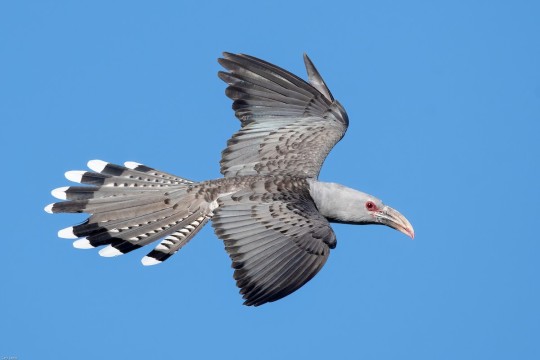
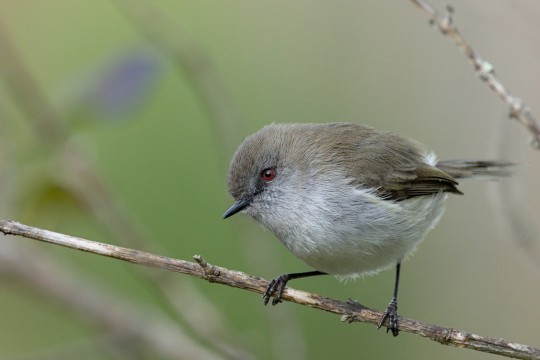
sources under cut
Channel-billed Cuckoo Propaganda
"they're the largest species of cuckoo! they call at night, it's always so jarring to hear birdsong at night, it's really cool when they're around, I've only seen them once or twice but I've heard them so many times"
"Pairs work together in order to aid the laying of eggs in host nests; the male will fly over the nest in order to provoke the nest occupants into a mobbing response, whereupon the female will slip into the nest and lay an egg. Alternatively the pair may work together by attacking an incubating bird, driving it off the nest and allowing the female to lay."
In northern Australia, their migration coincides with the rainy season and has lead to various nicknames such as "storm-bird", "flood-bird", or "rain-bird". They've also been given the nickname "fig hawk", as they are frugivorous and often have the soaring outline of a hawk.
Riroriro Propaganda
"I think they're neat, I hear them all the time, although I don't see them that much as they are rather cryptic. Also their nests are funky."
Also known as: Grey warbler, Gray gerygone, teetotum, or rainbird.
"Grey warblers are unique among New Zealand birds in building a pear-shaped nest with a side entrance near the top." In Maori culture, the riroriro is seen as an indicator of upcoming weather conditions for a season. This is due to the way they may direct the entrance of their nest, with an east-facing nest meaning a poor season brought by Western winds and a north-facing nest suggesting a pleasant season brought by Southern winds. Their spring singing was also seen as a signal to begin planting crops.
Image Source: Cuckoo (Cary Lewis); Riroriro (Christopher Tuffley)
#hipster bird main bracket#polls#round 1#channel-billed cuckoo#grey warbler#riroriro#bracket: fave b
21 notes
·
View notes
Text
Lasă-mă să dorm
cânta cucu, bată-l vina
l-aș călca eu cu mașina
#cânta cucu-ntr-un smochin#am să rup firul divin#but seriously there is a channel-billed cuckoo and it will not shut up#i write poetry sometimes#also whatever this is
2 notes
·
View notes
Text

The juvenile channel-billed cuckoos have grown up and flown away and this guy was the last of them. Won't see them again until September, when they migrate and lay eggs in the nests of local currawongs.
Bexley, NSW February 2025
0 notes
Text
Round 3 - Reptilia - Cuculiformes
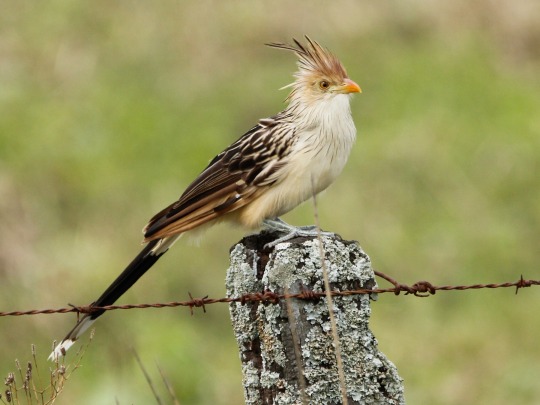

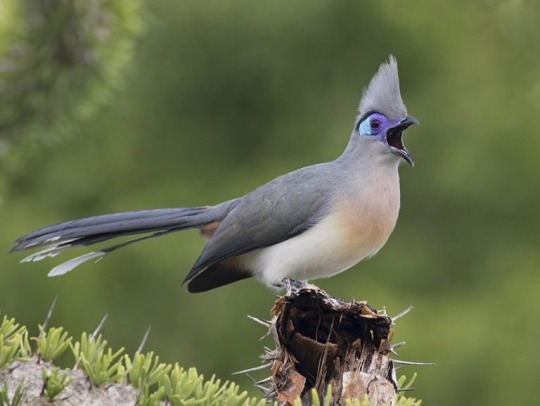
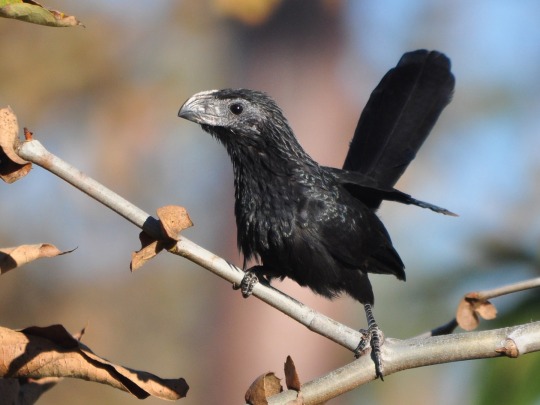
(Sources - 1, 2, 3, 4)
Our next order of birds are the Cuculiformes, commonly called “cuckoos”. Cuculiformes contains one living family, Cuculidae, and 33 genera.
Cuckoos are generally medium-sized, slender, intelligent birds. Most live in trees, though some are primarily ground-dwelling. They feed on insects, insect larvae, and a variety of other animals, as well as fruit. Their feet are zygodactyl, meaning that the two inner toes point forward and the two outer backward. Arboreal species tend to be more slender have short tarsi, while terrestrial species are more heavy set and have longer tarsi for running. Almost all cuckoos have long tales that are used for steering during either flying or running. Some species have cryptic plumage, while others have bright, elaborate, or iridescent plumage. They live all over the world’s continents except Antarctica, in habitats ranging from rainforest to desert. Some are migratory.
Most cuckoos are monogamous, though exceptions exist. Cuckoos are usually solitary, and only some species can be found in pairs or groups. However, during the breeding season a pair will spend time together, sometimes bringing each other gifts of insects or fruit. Some species of cuckoo are brood parasites. Brood parasites will lay their eggs in the nests of other birds, in some cases while the male distracts the host parents. Their eggs sometimes look similar to the eggs of their chosen hosts, though they usually have thicker and stronger shells. This protects the egg if a host parent tries to damage it. The cuckoo egg hatches earlier than the host eggs, and the cuckoo chick grows faster; in most cases, the chick instinctively evicts the eggs and/or young of the host species. In some species the cuckoo chick does not harm the other eggs or chicks intentionally, but will outcompete them for food. However, the majority of cuckoo species are not brood parasites, and their nests vary in shape from shallow platforms of twigs, to globular or domed nests of grasses, to saucers or bowls on the ground, to simply being laid directly on the ground. Non-parasitic species lay white eggs, and both male and female are usually involved in care of the eggs and chick. The young of all species are altricial, born weak and featherless, though non-parasitic cuckoos leave the nest before they can fly.
Cuculiformes are part of the clade Otidimorphae, which also includes the Musophagiformes (turacos) and Otidiformes (bustards). Otidimorphs arose in the Eocene, around 34 million years ago. One of the oldest known cuckoos is Dynamopterus velox from the Oligocene.

Propaganda under the cut:
While most species of cuckoo are solitary and secretive, the Anis (genus Crotophaga) (image 4) tend to be the exception to this rule. They live and nest communally, with a large nest being built by several pairs in which a number of females lay their eggs and then share incubation, feeding, and territorial defense duties. They also tend to be extremely trusting and friendly towards humans and other species.
Many cuckoos will eat the noxious, hairy caterpillars avoided by other birds. They can do this by rubbing the caterpillar back and forth on a branch to rub off their venomous hairs, and then crushing it with special bony plates in the back of their mouth.
The smallest cuckoo is the Little Bronze Cuckoo (Chalcites minutillus) which is 15-16 cm (5.9-6.3 in) long and weighs 14.5-17 grams (0.51-0.60 oz). It feeds on insects and while it usually hunts alone, it has often been seen hunting in groups of up to 5 birds.
Meanwhile, the Channel-billed Cuckoo (Scythrops novaehollandiae) is the largest living cuckoo, at 56–70 cm (22–28 in) long, with a 88–107 cm (35–42 in) wingspan, and weighing between 560–935 g (1.2–2 lb). The Channel-billed Cuckoo is a brood parasite, and also the largest brood parasite in the world. They parasitize the nests of larger Australian birds, such as ravens (genus Corvus), currawongs (genus Strepera), and butcherbirds (family Artamidae).
The fastest cuckoos are the Roadrunners (genus Geococcyx) (see gif above), which have been recorded running at 32 km/h (20 mph).
The Black Coucal (Centropus grillii) is unique among cuckoos for being polyandrous, with males tending to the nests while the larger female patrols the territory. A female’s territory can contain several nests with a different male at each nest, and males will often adopt the eggs and chicks of other males.
Cuckoos are a heavily present symbol in many human cultures. In Ancient Greek mythology, the god Zeus transformed himself into a cuckoo so that he could seduce the goddess Hera, to whom the bird was sacred (women in Ancient Greek mythology were frequently attracted to birds.) Three sacred cuckoos appear in the Finnish epic the Kalevala, connected to the death of a young girl who was being forced into marriage. In India, cuckoos are sacred to Kamadeva, the god of desire and longing, whereas in Japan, the cuckoo symbolises unrequited love. Cuckoos are a sacred animal to the Bon religion of Tibet. In Germany, a cuckoo clock is a classic pendulum-driven clock that mimics the call of a Common Cuckoo (Cuculus canorus) (image 2), complete with an automated cuckoo bird that moves with each note. Additionally, the brood parasitism of some cuckoo species gave rise to the term "cuckold", referring to the husband of an adulterous wife.
216 notes
·
View notes
Text
daily birds week 39!


channel-billed cuckoo + warbling white-eye


caspian tern + american redstart


chestnut-naped forktail + agami heron

boat-billed heron
222 notes
·
View notes
Text




new batch of fursona assignments over at ko-fi!
OG compilation (with over 70 images)
post #2
post #3
post #4
post #5
post #6
post #7
post #8
post #9
post #10
post #11 (you are here!): smew, bilby, channel-billed cuckoo, malayan crested fireback
assigning you little guys based on vibes! 💗
46 notes
·
View notes
Text
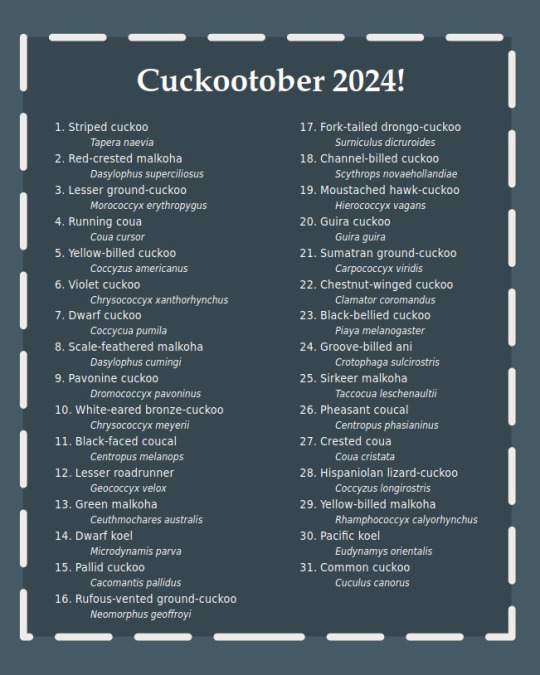
I had a lot of fun doing Avian August this year, but the focus on a single family of birds had me thinking a lot about how much I love cuckoos and the sheer variety they have, so I decided I would make my own list... Please join me for #Cuckootober !!
Prompt list in plain text under the cut:
1. Striped cuckoo (Tapera naevia) 2. Red-crested malkoha (Dasylophus superciliosus) 3. Lesser ground-cuckoo (Morococcyx erythropygus) 4. Running coua (Coua cursor) 5. Yellow-billed cuckoo (Coccyzus americanus) 6. Violet cuckoo (Chrysococcyx xanthorhynchus) 7. Dwarf cuckoo (Coccycua pumila) 8. Scale-feathered malkoha (Dasylophus cumingi) 9. Pavonine cuckoo (Dromococcyx pavoninus) 10. White-eared bronze-cuckoo (Chrysococcyx meyerii) 11. Black-faced coucal (Centropus melanops) 12. Lesser roadrunner (Geococcyx velox) 13. Green malkoha (Ceuthmochares australis) 14. Dwarf koel (Microdynamis parva) 15. Pallid cuckoo (Cacomantis pallidus) 16. Rufous-vented ground-cuckoo (Neomorphus geoffroyi) 17. Fork-tailed drongo-cuckoo (Surniculus dicruroides) 18. Channel-billed cuckoo (Scythrops novaehollandiae) 19. Moustached hawk-cuckoo (Hierococcyx vagans) 20. Guira cuckoo (Guira guira) 21. Sumatran ground-cuckoo (Carpococcyx viridis) 22. Chestnut-winged cuckoo (Clamator coromandus) 23. Black-bellied cuckoo (Piaya melanogaster) 24. Groove-billed ani (Crotophaga sulcirostris) 25. Sirkeer malkoha (Taccocua leschenaultii) 26. Pheasant coucal (Centropus phasianinus) 27. Crested coua (Coua cristata) 28. Hispaniolan lizard-cuckoo (Coccyzus longirostris) 29. Yellow-billed malkoha (Rhamphococcyx calyorhynchus) 30. Pacific koel (Eudynamys orientalis) 31. Common cuckoo (Cuculus canorus)
#cuckootober#birblr#birds#cuckoos#i don't particularly expect anyone else to do this#but i must share the love of cuckoo diversity#so i'm posting it all official-like. for fun :)#because i am gripped with the madness (enamored with cuckoos)
18 notes
·
View notes
Text
I will now assign seekers birdcalls (G1 standard)
Skywarp: Northern mocking bird
Thundercracker: Singing Nightingale
Sunstorm: Emperor Penguin
Slipstream: Red Tailed Hawk
Acid storm: American Crow
Nova storm: Black footed albatross
Thrust: Capuchinbird
Starscream is too special not to have two: Common Loon/Channel-billed Cuckoo (battlefield voice)
Ramjet: Trumpeter Swan
Dirge: Barred Owl
Ion storm: African spoonbill
Bitstream: Jack Snipe
————
Multiverse Starscream bird calls:
Earthspark: Ruby-throated Hummingbird
Robots in disguise: Mallard
Armada: Mourning Dove
Tfa: Flamingo
Bayverse: Puffin
IDW: Northern Lapwing
Cyberverse: Black footed albatross
Shattered Glass: Shoebill Stork
I’m not saying these were good assignments, but they happened anyway
#transformers#transformers seekers#Starscream#g1 starscream#imagine passing by the Decepticon#air barracks and hearing all this at once#tfa starscream#armada starscream#earthspark starscream#rid starscream#cyberverse starscream#shattered glass starscream#is the only one#I stand completely behind#I know you’re all mad I ‘forgot’ one
146 notes
·
View notes
Text
Day 13/30 - Channel Billed Cuckoo

81 notes
·
View notes
Text
first channel-billed cuckoos of the spring have arrived in my neighbourhood :)
11 notes
·
View notes
Text
“man i wish there was a eerie hooting/whistle noise at night”
the humble channeled billed-cuckoo :

3 notes
·
View notes
Text
Round 2, Poll 5
Prothonotary Warbler vs Channel-billed Cuckoo


sources under cut
Prothonotary Warbler
"Truly a sleeper warbler. Classy color scheme, lots of spunk. We saw a handful at Magee Marsh last month and I've been calling him America's little darling ever since."
"prothonotary warblers are an indicator species for healthy bottomland hardwood forests in the lower Mississippi"
The only Eastern warbler that uses cavity nests! There are only two warbler species- out of 117!- that use cavities like nest boxes or old woodpecker nests.
Channel-billed Cuckoo
"they're the largest species of cuckoo! they call at night, it's always so jarring to hear birdsong at night, it's really cool when they're around, I've only seen them once or twice but I've heard them so many times"
"Pairs work together in order to aid the laying of eggs in host nests; the male will fly over the nest in order to provoke the nest occupants into a mobbing response, whereupon the female will slip into the nest and lay an egg. Alternatively the pair may work together by attacking an incubating bird, driving it off the nest and allowing the female to lay."
In northern Australia, their migration coincides with the rainy season and has lead to various nicknames such as "storm-bird", "flood-bird", or "rain-bird". They've also been given the nickname "fig hawk", as they are frugivorous and often have the soaring outline of a hawk.
#hipster bird main bracket#polls#prothonotary warbler#channel billed cuckoo#bracket: fave b#warbler#cuckoo#cuculidae#parulidae#round 2
10 notes
·
View notes
Text
heard the first channel-billed cuckoo call of the season, spring is coming. it has just made its way from papua new guinea to here, where it will parasitise the nests of local birds with its eggs and then next autumn those babies will fly to papua new guinea too
5 notes
·
View notes
Text
January 2024 books!
I had some vacation this month. I also had an entire week when I was stuck at home without internet due to the ice storm. So I read a lot, mostly very light, fluffy comfort read books.
What I read:
Nine Goblins by T. Kingfisher. A novella about war as experienced by goblins. As usual from a TK book, a little gory, a lot witty, with some fun characters.
The Graveyard Book by Neil Gaiman. I've read so little of Neil Gaiman's books and I really enjoyed this one. I thought it was quite inventive and I liked how the passing of time was framed.
Friends, Lovers, and the Big Terrible Thing by Matthew Perry. It's an odd experience reading a book written by a person who has died. He had a lot of mental health problems, and I'm so sad that the medical world failed him so much.
All Systems Red by Martha Wells (audiobook). I read the novella last year and have been wanting to read the whole series, but I had already forgotten details, hence the audiobook. It was a great way of seeing things through Murderbot's eyes. I just got the next book from the library, so that will be my next listen, I think.
Miss Buncle's Book by D.E. Stevenson. A very charming book about a woman who scandalized her hometown by writing a book about them. Reminded me a lot of L.M. Montgomery's short stories.
Lord of the Butterflies by Andrea Gibson. A book of poetry exploring love and family and gender. So much emotion packed into every poem. Truly lovely.
The Wee Free Men by Terry Pratchett. I've also not read much of Sir Terry's and everybody has recommended the Tiffany Aching series. It was a lot of fun and had some very unique characters.
Iron Flame by Rebecca Yarros. This is not high fantasy, but when the frozen world was coming down around me, this was exactly the kind of escape fiction I needed.
Weyward by Emilia Hart. Three stories woven into one about generations of women who are witches. There wasn't anything that really unique about the book, but it had great atmosphere.
An Unexpected Twist by Andy Borowitz. Not sure I should really count an 18 page essay as a book, but I enjoyed this perspective of the medical system from somebody experiencing complications.
Thank You for Listening by Julia Whelan. Okay, it mostly stretched credibility, but I enjoyed the banter between the love interests. And I especially liked the way the MC was dealing with her grandmother's dementia.
Georgie, All Along by Kate Clayborn. I enjoyed this one. I appreciated that while it was a "going home to the small town" trope, it also didn't paint that as solving all of the problems.
Upstream: Selected Essays by Mary Oliver. I started reading this last year and it took me to finish. Some of the essays were gorgeous, some felt unfinished, and others felt like book reports.
The Kiss Quotient by Helen Huang. I nearly DNF at 90% because I was so mad at the "chivalrous" macho possessive behavior of the male character. There was a lot of gender roles and conformity and casual (and not so casual) sexism throughout. Oh the other hand, the sex was plenty and pretty well described.
What I'm currently reading:
Cloud Cuckoo Land by Anthony Doerr. My sister recommended this. I'm about half way through and it's a tale interweaving people from the past and the future. It's at a point where it feels like bad things are going to start happening, so I'm a touch anxious, but it's been excellent so far.
Poverty. by America by Matthew Desmond (audiobook). I'm an hour in and it's utterly horrifying and gutting.
A Short History of Nearly Everything by Bill Bryson. It's a 20 year old book at this time and needs an update, but it certainly makes science understandable.
The Six: The Untold Story of America's First Women Astronauts by Loren Grush.
The Summer Tree by Guy Gavriel Key. I remember reading this in high school and really liking it (while also feeling dirty because there was some swearing and a sex scene in it). This time though? It's obvious he's channeling Tolkien, the writing is painfully stilted and the premise is weak and I've found out that it's a sort of King Arthur retelling, so I'm just not sure about it.
What I plan on reading next:
Emily Wilde's Map of the Underworld, Tom Lake (audiobook), and The Starless Sea are next on my list, I think.
8 notes
·
View notes
Text

new favourite bird !!! channel billed cuckoo :3
(photo by paul balfe)
25 notes
·
View notes